Metal hydroxides Study guides, Class notes & Summaries
Looking for the best study guides, study notes and summaries about Metal hydroxides? On this page you'll find 50 study documents about Metal hydroxides.
Page 4 out of 50 results
Sort by
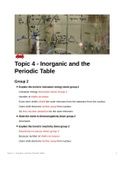
-
A Level Edexcel Chemistry - Topic 4 - Inorganic Chemistry and the Periodic Table
- Class notes • 12 pages • 2022
-
- $10.41
- + learn more
A Level Edexcel Chemistry - Topic 4 - Inorganic Chemistry and the Periodic Table Fully updated notes providing drop down answers to self made questions designed from numerous textbooks and exam mark schemes. During my revision, I created these drop down questions and answers by extracting the key information needed to achieve top marks in exams. I achieved a high A* using only these notes. Notes for all other topics have been released on my page :) Hope I can help!
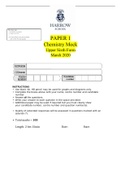
-
PAPER 1 Chemistry Mock Upper Sixth Form March 2020
- Exam (elaborations) • 48 pages • 2022
-
- $12.28
- + learn more
PAPER 1 Chemistry Mock Upper Sixth Form March 2020 INSTRUCTIONS • Use black ink. HB pencil may be used for graphs and diagrams only. • Complete the boxes above with your name, centre number and candidate number. • Answer all the questions. • Write your answer to each question in the space provided. • Additional paper may be used if required but you must clearly show your candidate number, centre number and question number(s). • Quality of extended responses will be as...

-
General Chemistry Questions & Answers
- Exam (elaborations) • 22 pages • 2024
- Available in package deal
-
- $12.99
- + learn more
General Chemistry Questions & Answers 2[A]=B+C forward and reverse reactions - CORRECT ANSWER - rate(forward)=kf[A]^2 rate(reverse)=kr[B][C] rate(forward)=rate(reverse) equilibrium Kc=equilibrium constant=([B][C])/[A]^2 Kc=Keq=kf/kr 7 general solubility rules (5,6,7) - CORRECT ANSWER - 5) all metal oxides are insoluble, unless formed with alkali metals, ammonium, and CaO, SrO, and BaO, all of which hydrolize to form hydroxides 6) all hydroxides insoluble with the exception of those form...
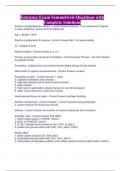
-
Entrance Exam Semmelweis Questions with Complete Solutions
- Exam (elaborations) • 18 pages • 2024
-
Available in package deal
-
- $8.99
- + learn more
Electron configuration for cations - Correct Answer Subtract 1 from exponent of highest n-value orbital (ex. remove from 4s before 3d) Ag+ = [Kr]5s^1 4d^9 Electron configuration for anions - Correct Answer Add 1 to closest orbital Cl- = [Ne]3s^2 3p^6 Atomic orbitals - Correct Answer s, p, d, f Primary vs secondary structures of proteins - Correct Answer Primary - AA chain (linked by peptide bonds) Secondary - stabilized by non-covalent bonds (alpha helices & beta sheets) Mos...
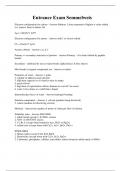
-
Entrance Exam Semmelweis
- Exam (elaborations) • 18 pages • 2024
-
- $12.49
- + learn more
Electron configuration for cations - Answer-Subtract 1 from exponent of highest n-value orbital (ex. remove from 4s before 3d) Ag+ = [Kr]5s^1 4d^9 Electron configuration for anions - Answer-Add 1 to closest orbital Cl- = [Ne]3s^2 3p^6 Atomic orbitals - Answer-s, p, d, f Primary vs secondary structures of proteins - Answer-Primary - AA chain (linked by peptide bonds) Secondary - stabilized by non-covalent bonds (alpha helices & beta sheets) Most bonds in organic compounds are - Answer-...

-
Entrance Exam Semmelweis
- Exam (elaborations) • 18 pages • 2024
-
- $12.99
- + learn more
Electron configuration for cations Subtract 1 from exponent of highest n-value orbital (ex. remove from 4s before 3d) Ag+ = [Kr]5s^1 4d^9 Electron configuration for anions Add 1 to closest orbital Cl- = [Ne]3s^2 3p^6 Atomic orbitals s, p, d, f Primary vs secondary structures of proteins Primary - AA chain (linked by peptide bonds) Secondary - stabilized by non-covalent bonds (alpha helices & beta sheets) Most bonds in organic compounds are covalent Properties of water 1. polar 2. capab...
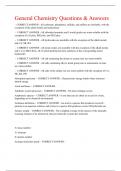
-
General Chemistry Questions & Answers
- Exam (elaborations) • 9 pages • 2024
- Available in package deal
-
- $12.89
- + learn more
General Chemistry Questions & Answers - CORRECT ANSWER - All carbonate, phosphates, sulfides, and sulfites are insoluble, with the exception of the alkali metals and ammonium - CORRECT ANSWER - All chlorides bromides and I would guides are water-soluble with the exception of a G plus, PB2 plus, and HG2 plus - CORRECT ANSWER - All hydroxides are insoluble with the exception of the alkali metals and CA, SR, BA - CORRECT ANSWER - All metal oxides are insoluble with the exception of the alkal...
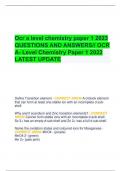
-
Ocr a level chemistry paper 1 2023 QUESTIONS AND ANSWERS// OCR A- Level Chemistry Paper 1 2022 LATEST UPDATE Define Transition element - CORRECT ANSW-A d-block element that can form at least one stable ion with an incomplete d subshell
- Exam (elaborations) • 18 pages • 2024
-
- $12.49
- + learn more
Ocr a level chemistry paper 1 2023 QUESTIONS AND ANSWERS// OCR A- Level Chemistry Paper 1 2022 LATEST UPDATE Define Transition element - CORRECT ANSW-A d-block element that can form at least one stable ion with an incomplete d subshell Why aren't scandium and Zinc transition elements? - CORRECT ANSW-Cannot form stable ions with an incomplete d-sub shell. Sc 3+ has an empty d-sub shell and Zn 2+ has a full d sub shell. Name the oxidation states and coloured io...
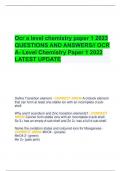
-
Ocr a level chemistry paper 1 2023 QUESTIONS AND ANSWERS// OCR A- Level Chemistry Paper 1 2022 LATEST UPDATE Define Transition element - CORRECT ANSW-A d-block element that can form at least one stable ion with an incomplete d subshell
- Exam (elaborations) • 18 pages • 2024
-
- $12.99
- + learn more
Ocr a level chemistry paper 1 2023 QUESTIONS AND ANSWERS// OCR A- Level Chemistry Paper 1 2022 LATEST UPDATE Define Transition element - CORRECT ANSW-A d-block element that can form at least one stable ion with an incomplete d subshell Why aren't scandium and Zinc transition elements? - CORRECT ANSW-Cannot form stable ions with an incomplete d-sub shell. Sc 3+ has an empty d-sub shell and Zn 2+ has a full d sub shell. Name the oxidation states and coloured io...
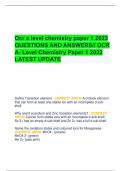
-
Ocr a level chemistry paper 1 2023 QUESTIONS AND ANSWERS// OCR A- Level Chemistry Paper 1 2022 LATEST UPDATE Define Transition element - CORRECT ANSW-A d-block element that can form at least one stable ion with an incomplete d subshell
- Exam (elaborations) • 18 pages • 2024
-
- $11.99
- + learn more
Ocr a level chemistry paper 1 2023 QUESTIONS AND ANSWERS// OCR A- Level Chemistry Paper 1 2022 LATEST UPDATE Define Transition element - CORRECT ANSW-A d-block element that can form at least one stable ion with an incomplete d subshell Why aren't scandium and Zinc transition elements? - CORRECT ANSW-Cannot form stable ions with an incomplete d-sub shell. Sc 3+ has an empty d-sub shell and Zn 2+ has a full d sub shell. Name the oxidation states and coloured io...

Do you wonder why so many students wear nice clothes, have money to spare and enjoy tons of free time? Well, they sell on Stuvia! Imagine your study notes being downloaded a dozen times for $15 each. Every. Single. Day. Discover all about earning on Stuvia


